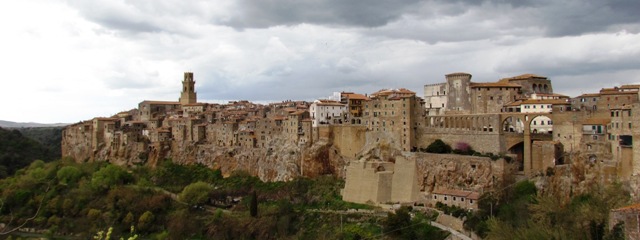 Well, Stefano and I meant this to be an Easter birding trip. But sometimes things don’t go as planned: there were very few birds in the WWF “oasis” at the lagoon of Orbetello, in southwestern Tuscany. We did spot an avocet way off in the distance, but that was about it. Not the most spectacular time of year for birding in this area, we were told. Come back in the winter, we were told. And we will! 🙂
Well, Stefano and I meant this to be an Easter birding trip. But sometimes things don’t go as planned: there were very few birds in the WWF “oasis” at the lagoon of Orbetello, in southwestern Tuscany. We did spot an avocet way off in the distance, but that was about it. Not the most spectacular time of year for birding in this area, we were told. Come back in the winter, we were told. And we will! 🙂
So on Sunday we decided to forget about the birds and instead visit some of the ancient Etruscan sites.  First we went to the Vie Cave (= “excavated roads”), which is an impressive road network linking an Etruscan necropolis and several settlements in the area between Sovana, Sorano and Pitigliano, consisting mainly of trenches excavated as nearly vertical cliffs in tuff, sometimes over twenty feet high, possibly serving as an effective defense system against invaders (source: Wikipedia).
First we went to the Vie Cave (= “excavated roads”), which is an impressive road network linking an Etruscan necropolis and several settlements in the area between Sovana, Sorano and Pitigliano, consisting mainly of trenches excavated as nearly vertical cliffs in tuff, sometimes over twenty feet high, possibly serving as an effective defense system against invaders (source: Wikipedia).
Please notice the use of the word “possibly.” To this day, in fact, nobody knows for sure what the purpose of this huge excavation project was. What we do know is that no other ancient population built anything like this. Anywhere in the world. How about that? 
So if you are visiting Tuscany, and if you enjoy walking and a bit of climbing…and have an extra day (after going to Siena, San Gimignano, Pienza and so on), get yourself some sturdy trekking shoes (you don’t need to be super fit, but some of the paths can be a bit treacherous and/or steep) and go to the “Parco Archeologico Città del Tufo,” located near the town of Sovana.
A short, easy walk will take you to the so-called “Tomb of Hildebrand,” or Tomba di Ildebranda (third century BC; photo no. 1)). It’s a huge temple tomb and is considered to be the most important Etruscan monument…You can visit the underground crypt and, if you feel like it, also climb up to a sort of alcove on the left side of the temple tomb, which offers a very nice panoramic view.  Yep, that was pretty. And impressive!
Yep, that was pretty. And impressive!
Oh, by the way, the tomb was named “Ildebranda” after pope Gregory VII (11th century AD), whose birth name was Ildebrando di Soana. Anyway, from this massive tomb you can visit a few other, smaller tombs, and then the trail takes you over to the excavated roads…This was the most fascinating part, for me, of the entire circuit. I particularly liked the one called “Il Cavone,” one of the biggest and most famous.
Walking along these ancient, tall, massive, narrow, winding and bending corridors was, well, a magical experience. I can’t find the words to describe how I felt, but, whatever it was, it was strong. Stefano felt the same way, too. In part, I suppose it’s because here and there you find yourself walking in the semi-darkness caused by the interlocking, ivy-covered oak trees looming overhead and casting shadows on the path even on the brightest of days…

Don’t walk too quickly…take your time…look up at the vegetation, listen to the birds and make sure to look out for the tombs cut into the rock. Amazing.
And don’t leave the area without hiking up to the Tomb of the Siren (photo no. 4), which is on the other side of the road. A short walk will take you to the part of the archaeological area called Area Archeologica di Sopraripa. Some of the tombs there date to the 7th-6th century BC, by the way. 
The Tomb of the Siren (third century BC), which you will reach after a bit of a climb, is an aedicule tomb depicting the monster Scylla (not a siren at all…) seizing a couple of Ulysses’ companions. Lovely.
By the time we got back to the parking lot, we were really ready for a bite to eat. So we set off for the town of Pitigliano (photo no. 5). This was not actually my first visit to Pitigliano. I went there to participate in a grape harvest (vendemmia, in Italian) almost 30 years ago. But I’d forgotten how lovely this town is, perhaps “saved” by the fact that it is not a major tourist destination here. And I’d forgotten about the jackdaws or taccole (see previous post). I don’t remember seeing those at all!
But back then, of course, I wasn’t a birdwatcher. 😉
I have a busy afternoon, so I must sign off here. More soon!















